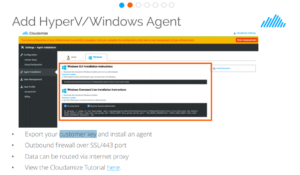Cloudamize and other Right sizing tools
What IS RIGHT sizing?
Traditional on-premises infrastructure is , typically, over-provisioned. Prior to moving your instances to the public cloud, it is recommended that you perform a ‘right sizing’ exercise – using a tool such as Cloudamize, Cloudphysics, Stratozone or Movere.
What Right-sizing means
a) achieving your best-fit cloud configuration, which includes having the optimal compute, storage, and network settings – as well as
b) the best pricing plan – that will enable you to achieve your maximum performance requirements at the lowest possible cost
Cloudamize is a pricing and cost prediction tool that can be used to better understand what your cloud hosting costs may look like, BEFORE you actually move to the cloud.
vCenter Based Data Collection
Cloudamize effectively logs into vCenter (or HyperV Management Center) to query the underlying vCenter database. From here, it can gather most of the hardware metrics it needs. It does this over a period of 2 weeks (recommended).
First Step – Configuring vCenter to be accessed from Cloudamize
- Create a new Read-only account inside vCenter.
- Provide Cloudamize with the IP address (public or private), and the read-only credentials just created.
- If the vCenter VM has a Public IP, we just need one additional step:
- Ensure that TCP port 443 is open outbound to the vCenter data collector at IP address 184.72.252.123
-
If your vCenter IP address is a private (e.g. 10.x.x.x or 192.168.x.x) IP address:
- A) we will need you to install a ‘Cloudamize Proxy’ that will forward data to Cloudamize server.
- B) You will need to allow outbound traffic on port 443 to IP address 184.73.183.154.
- C) You will also need to allow traffic on port 443 from vCenter to the vCenter IP address.
Agent Based Data Collection
- Agents are installed via AD Group Policies. Agents communicate back directly to the Cloudamize Server, using a Customer specific, ACCESS KEY that is provided to the customer.
- Open TCP port 443 outbound to the Cloudamize agent data collector at IP address 104.197.11.97.
- Install the Cloudamize Windows agent via the GUI installer, Command Prompt, or any number of deployment tools like Chef, Puppet, SCCM, etc.
Agent Install (Windows Servers)
- When a proxy server is not used,
- msiexec /i <downloaded MSI file> CUSTOMERKEY=”your key” (customer Key)
- When a proxy server is used but proxy credentials are not used,
- msiexec /i <downloaded MSI file> CUSTOMERKEY=”your key” USE_PROXY=1 HTTPS_PROXY=”https://www.your_own_proxy.com” PROXY_PORT=”your_proxy_server_port”
- When a proxy server is used and proxy credentials are used,
- msiexec /i <downloaded MSI file> CUSTOMERKEY=”your key” USE_PROXY=1 HTTPS_PROXY=”https://www.your_own_proxy.com” PROXY_PORT=”your_proxy_server_port” USE_PROXY_CREDENTIAL=1 PROXY_USER_NAME=”user_name” PROXY_PASSWORD=”password”
Pricing model for Cloudamize
Pricing is per VM. Approximately, $60 MSRP per VM
Getting a Customer Started
From your cloudamize portal, you should be able to export the customer key. This goes into the URL that is provided to the customer for the agent install.

Can it gather data from private clouds?
Yes. Check this doc
What can it do?
Based on the discovery results, one can perform Budgeting Exercises (vCenter or Agent based are equivalent) and Application Dependency Mapping (need agent based assessment for this).
From Cloudamize’s official documentation:
➜ Semi Automated Discovery : Automatically identify all
applications and machines within the environment, and choose which are to be
considered with inventory settings.
➜ Application Dependency Mapping : (Need agent based discovery for this)
Map all application dependencies across your on-premises and cloud environments,
including 3-tier/n-tier dependencies, and zoom in on individual dependencies to
view details on all processes, such as executable names, application names and
descriptions, vendor information wikis, and more to ensure a seamless migration.
➜ App Complexity Analysis: Determine an application’s complexity based on its
classification, dependencies, CPU usage, and platform portability to understand
which applications you should prioritize for early migration vs. which should
move in later phases.
➜ Cloud Suitability Analysis: Capture an application’s
cloud compatibility and efficiency gain based on its performance profile, usage
patterns, and available cloud options to prioritize applications for migration
and determine which should stay on-premises.
➜ Application Classification:
Applications are automatically grouped together from over 200 pre-built application classes compiled over 10,000 applications, such as business intelligence, security, and IT Management, so you can quickly identify which applications to move and when using classifications that align to your
organizational needs and structure.
➜ Intelligent Move
Groups: Automatically group hundreds or even thousands of applications migrating to the cloud based on characteristics such as application or machine names,
affinity mapping, dependencies, cloud cost, application class, cost, migration phase, or any other user-defined filter.
➜ Migration Designer: Manually group
applications based on their dependencies, business uses, migration phases, tags, and more. ➜ TCO to Migrate: See how much a workload will cost in the cloud
before you migrate it to ensure you only migrate those workloads that fit into your current migration budget.
➜ Move Group Planning: Run “what if” scenarios for each move group by changing regions, pricing plans, discounting levels,
instance types, instance families, and performance thresholds to decide
migration priority of the move group.
➜ Shadow IT: Find potential “Shadow IT” by identifying dependencies going to IP addresses within your
environment that are out of project scope.
➜ Firewall Rules: View firewall rules for /8, /16, and /32 IP address range based on your application communication
and build your security policies in the cloud
➜ Export Data: Download summary reports for all groups/applications, which detail IP addresses, dependencies,
DNS, firewall rules, migration cost, and more.
➜ Export Architecture Diagram: Build your architecture diagram and export it into SVG format to edit for your
final configuration. ➜ Project Management: Manage multiple large-scale migrations across different business units and global geographies simultaneously
within a single portal.
Need an experienced AWS/GCP/Azure Professional to help out with your Cloud Strategy? Set up a time with Anuj Varma.
Leave a Reply